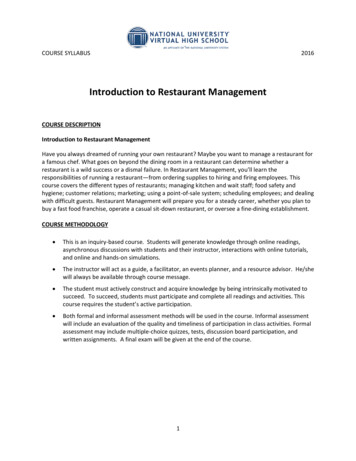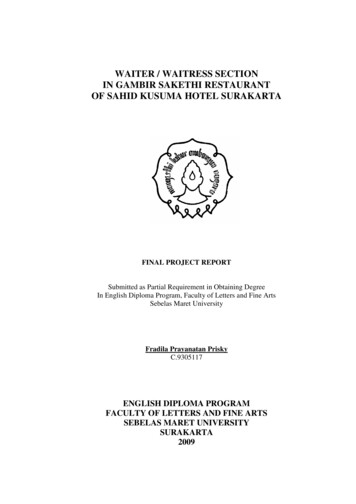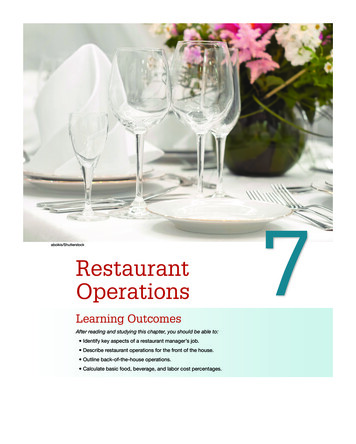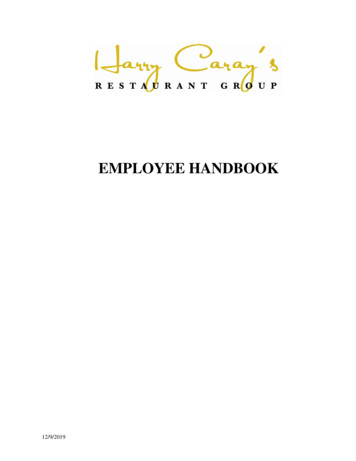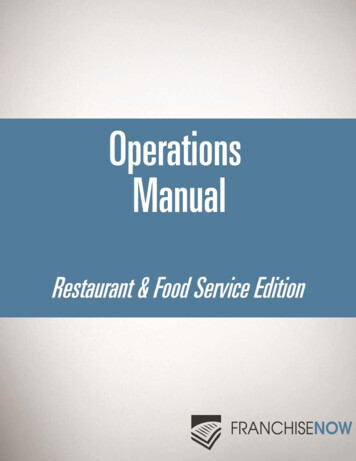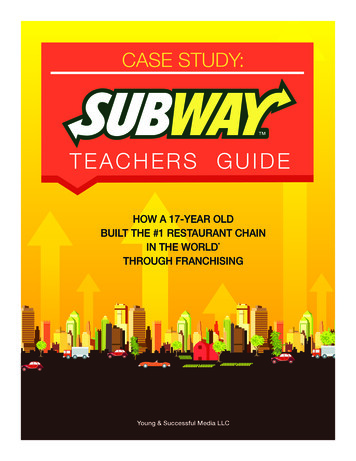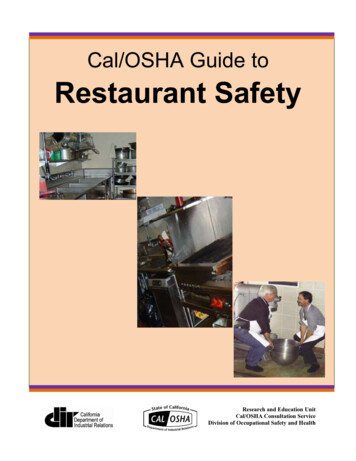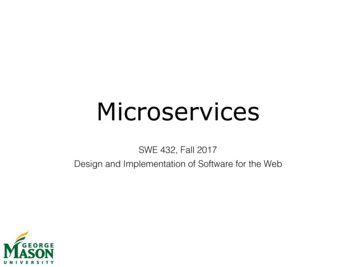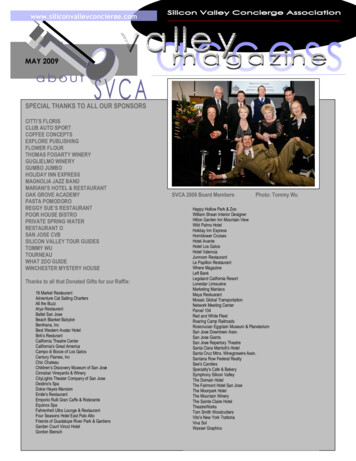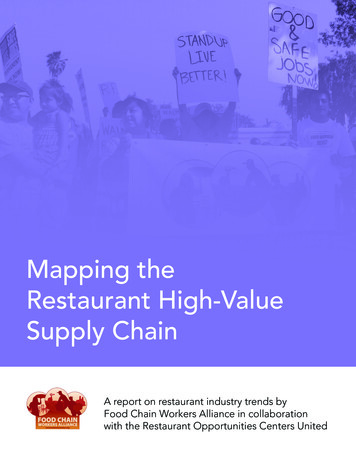
Transcription
Mapping theRestaurant High-ValueSupply ChainA report on restaurant industry trends byFood Chain Workers Alliance in collaborationwith the Restaurant Opportunities Centers United
Mapping theRestaurant High-ValueSupply ChainTABLE OF CONTENTS3Introduction5Methodology6Chapter 18Fabulous Freddie’s Fighting for Fair Food9Chapter 211 Conclusions12 Recommendations2
Mapping the Restaurant High-Value Supply ChainINTRODUCTIONThe food industry, composed of production (farm-workers), distribution (warehouse & logistics workers), processing (meat, poultry & foodprocessing workers), retail (grocery), and service (restaurants, food service establishments, and street vendors) is the largest employment sectorof the US economy.1 It is represented by a myriad of companies that practice a spectrum of employment practices. The vast majority of these foodemployers take a “low-road” approach by paying workers the minimumwage required under the law, and sometimes below minimum wage, aswell providing only unpaid sick leave and no opportunity for mobility andfollowing unsustainable business models. The hourly median wage forfrontline food workers is the lowest in the U.S. economy at 10 per hour,far below the 17.53 median for all other industries.2 10/ hrhourly medianwage forfrontline foodworkersHowever, there are a growing number of ethical employers who payliving wages and have made other improvements for frontline workers,therefore implying that these high-road businesses understand the industry differently than others. They perceive their workforces, communities,and the products and services theyoffer as equally fundamental to theircommercial success. Furthermore,most of these employers are also concerned with their carbon footprint andother environmental factors, animalwelfare, and local economies. Thesebusinesses are far ahead and take along-term view of their companies asa means to generate substantial, positive business and social impact. Several of these high-road businesses arethriving in part because of the supportof a new generation of consumerswho embrace a new type of economythat works for everyone in a healthyand sustainable manner. Consequently, the establishment of what is considered “good food” can be measured by3
Mapping the Restaurant High-Value Supply Chainfive critical categories: valued employees, environmental sustainability,animal welfare, nutrition, and local economies. It is now possible to identify how food producers, processors, suppliers, and retailers fit into thesecategories.This study aims to portray the primary aspects and practices ofthe high-road restaurant industry nationwide in relation to their supplychains, as well as to describe what it means to be a good food business,why it matters, and how policy can direct more companies to embracethese practices. In the first phase of the research, conducted via onlinesurvey, the majority of the over 150 respondents were restaurant owners,a total of sixty-two percent, who were asked about main features of therestaurant industry. During the second phase, in-person interviews wereconducted with restaurant CEOs to demonstrate the range of views andvalues in providing good food to consumers in the industry. This studycontains a geographical range of information, with responses gatheredacross the country, including from California, New York, Illinois, Michigan,Pennsylvania, Wisconsin, Texas, and Rhode Island.Whenrestaurants aligntheir values withtheir supplychain choices,they supportproducersand suppliersthat prioritizesustainability,equitable workerconditions, andlocal economies.By gathering knowledge about high road restaurant choices, thisstudy will help shape a program that allows high-road value chains tothrive via public institution contracts and individual consumer choices.Through this study, restaurants will be encouraged to continue or beginmaking high-road food choices, by seeing the many restaurants that remain viable while making sustainable and equitable food sourcing choices. The study aims to connect restaurants interested in furthering theirhigh-road practices. Increased collaboration will allow restaurants to havean easier and more comprehensive transition to creating or maintaininga status as a good food business. By encouraging restaurants to followhigh-road practices, this study will have an impact across the food system.The choices of restaurants have effects all the way down the supply chain.When restaurants align their values with their supply chain choices, theysupport producers and suppliers that prioritize sustainability, equitableworker conditions, and local economies. Demonstrating the supply chainrelationships between the diverse food sectors and organizations representing workers in the food system is necessary for enhancing workingconditions and wages in all parts of the food system.Through a participatory process, this report maps the sector, geographic reach, scale, and supply chain of high-road employers in the foodindustry that are members of the RAISE and Sanctuary restaurant networks. The data provides a clear picture of where good food is produced,processed, transported, served, and sold. This information will help topush consumers to high-road businesses, increasing demand and allowing a good food sector to flourish. High-road employers can be an integral part of policy change by exhibiting that prioritizing workers, animals,and the environment can be a sustainable and economically achievablebusiness model.Solidarity Research Cooperative (SRC) analysis of Occupational Employment Statistics, 2015. U.S.Bureau of Labor Statistics.1SRC analysis of wage and salary workers, Occupational Employment Statistics, 2015. U.S. Bureauof Labor Statistics.24
Mapping the Restaurant High-Value Supply ChainMETHODOLOGYThis study, made possible in part by a grant from Grace Communications Fund, surveyed over 150 restaurant owners and operators throughthe Restaurants Advancing Industry Standards in Employment (RAISE)network of restaurateurs. The study was conducted in two phases and iscomposed of two elements: 1. Quantitative data were gathered throughan online survey with open-ended questions at the beginning of 2018.These data were collected through a comprehensive questionnaire designed to capture the main aspects and practices of the restaurant industry nationwide vis-a-vis their supply chains. The restaurant employersreceived an invitation for the survey as their business might meet highstandards and are known leaders in the RAISE and Sanctuary restaurantnetwork. Participants were asked to answer questions about their restaurants, and, in exchange for filling out the survey, they were offered the possibility to showcase their better business practices on the Diners Guideapp to over 100,000 ethical customers who demand good food and goodwages. 2. Qualitative data were gathered in the Summer of 2018 via asample of restaurants that have proven high-value supply chains and others that do not. The interviews took between 30 minutes to 2 hours witheach restaurateur and are indicative of the spectrum of views and valuesin supplying good food to consumers available in the restaurant industry.5
Mapping the Restaurant High-Value Supply ChainCHAPTER 193%ranked workerwell-being andlocal economiesas a somewhator very importantpriority whilesourcing food.The survey completed for phase one of the study consisted ofquestions designed to learn more about the supply chain and restaurantpractices of high-road food employers. One of the main purposes of thesurvey was to further understand the values of survey participants andhow those values are seen in restaurant practices. About 99 percent ofparticipants felt that the foods served in their restaurants reflected theirrestaurants values. Employer values were also demonstrated by their foodsourcing priorities. Participants were asked to rank their priorities in foodsourcing, including nutritious foods, worker well-being, animal welfare,environmental sustainability, and local economies, in order of importancefrom one to five, with one being the least impoArtant and five being themost important. The highest ranked priorities were worker well-being andlocal economies: approximately 93 percent of participants ranked workerwell-being and local economies as a somewhat or very important prioritywhile sourcing food. The survey respondents also recognized environmental sustainability, nutrition, and animal welfare as important considerations: 80 percent or more respondents ranked these food sourcing considerations as somewhat or very important. The graph below highlightsthe average ranking for the five categories.Graph 1What are your priorities in sourcing food? In order of importance (rank 1-5 -- 1being the least important and 5 being the most important)4.74.64.54.44.34.2Nutritious food6Worker wellbeingAnimal welfareEnvironmentalsustainabilityLocal economies
Mapping the Restaurant High-Value Supply ChainParticipants were also asked about business practices in food sourcing from vendors, producers, and potential business partners. About 90percent of participants felt that sourcing from businesses that share theirsame values was most important when seeking potential business partners. Fifty-three percent of participants said they ask about employmentpractices when purchasing foods from a vendor or producer. This signalsa shift in thinking for entrepreneurs from a solely price-point focus to onethat is at best a balanced approach between price and principles.Participants were asked about where they were currently sourcingtheir ingredients and if those partners held any third-party certifications.The survey found that exactly 50 percent of participants sourced theirfoods from one or more worker-owned cooperatives. Cooperatives werethe top source of ingredients, followed by suppliers with any “Fair Trade”certification, Equitable Food Initiative (http://www.equitablefood.org),Fair Food Program (http://www.fairfoodprogram.org/partners/), B-corpcertification, some or all workers being unionized, Food Justice Certification (http://www.agriculturaljusticeproject.org), and those being a FoodJustice Certified vendor (http://www.argriculturaljusticeproject.org). Thegraph below highlights the range of certified food producers that restaurants source ingredients from.Graph 2Do you source ingredients from farms and food producers who hold any ofthe following third-party certifications?6%8%11%Equitable Food Initiative (http://www.equitablefood.org)10%Fair Food Program (http://www.fairfoodprogram.org/partners/)Food Justice Certification (http://www.agriculturaljusticeproject.org)10%Any “Fair Trade” certificationOther worker-owned cooperativeB-Corp28%26%Some or all workers are unionizedFood Justice Certified vendor (http://agriculturaljusticeproject.org)Individuals of undocumented status make up a great portion ofthose employed in the restaurant industry. Administrative policies canimpact the ways restaurants run and who they employ. We asked surveyparticipants if they felt that current immigration policies implemented inthe United States have made it difficult to adequately staff their businesses. 50 percent of participants felt that current immigration policies havemade it difficult to adequately staff their businesses, and 50 percent feltthey did not. However, 36 survey participants opted to “skip” the question instead of answering. This could possibly have been due to fear ofpossible retaliation by partners, employers, or employees if participantswere to answer “yes” or “no.”50%felt that currentimmigrationpolicies havemade it difficultto adequatelystaff theirbusinesses.7
Mapping the Restaurant High-Value Supply ChainFabulous Freddie’sFighting for Fair FoodFred and Denise Bertucci opened Fabulous Freddie’s Italian Eatery in 1990 in the Chicago neighborhood of Bridgeport. It started asan exclusively family-run business and has since expanded to employpeople outside of the family. It originally was about 1/3 of the currentsize with only a grill, deep fryer, and freezer. Over time, Fabulous Freddie’s purchased both the first and second floors of the building andhas become a profitable business to this day. It is mainly known for itslarge portions such as their Italian Beefs, Sausages, Meatballs, ItalianIce and much more. Due to the high demand of their food, they havehad to employ more people to fill necessary positions such as delivery drivers, catering staff, cooks, etc. Fabulous Freddie’s restaurantmanager, Joseph Passarelli is a relative of Fred Bertucci and has beena part of Fabulous Freddie’s for as long as he can remember. In an interview conducted in June of 2018, he highlighted his main prioritieswith food sourcing as having nutritious food for customers, followedby worker well-being, environmental sustainability, local economies,and animal welfare, in that order of importance. Passarelli stressedthat the food served in Fabulous Freddie’s highlights the values ofthe restaurant. When asked to speak further on this point, Passarellisaid, “When you give a customer bad food and they remember it, whywould they come back? They have no reason to. Freddie’s is all aboutgiving customers tasty food to keep them coming back and to spreadthe word to their loved ones. They win and we win this way. We’re afamily run business and we like to treat customers as if they are a partof the family too.”However, Fabulous Freddie’s has come across some difficultywhen sourcing their food. Their main challenge has been finding thebest quality of food at a fair price. Passarelli explains how charitiessuch as the Charles Tillman Foundation partnerships and donationshas benefited Freddie’s. The restaurant has mainly grown throughword of mouth and do not have many advertisements throughout Chicago but has still managed to be stable over the years. The topic ofthe current administration’s policies was also touched upon during theinterview. Passarelli explained his frustration with the current immigration policies that have made it extremely difficult to employ immigrantworkers due to fear of the current political and social climate. This hasmade it extremely difficult to employ more people to fit the necessarypositions needed to keep Fabulous Freddie’s running as efficiently asit has been over the previous years.8
Mapping the Restaurant High-Value Supply ChainCHAPTER 2The restaurant industry is represented by a wide range of “highroad” actors who have organized restaurant owners and workers to secure workplace justice, fight poor conditions and low wages, partner withaccountable restaurants, promote ethical and sustainable practices, andso forth. However, there are also association lobbies on nearly every issueaffecting the food system, from opposing the implementation of basicworkers’ rights to giving restaurant owners the choice of not enforcingliving wages, among other “low-road” practices.Representing food workers justice movements, the Restaurant Opportunities Centers United (ROC United) is one of the nation’s most prominent worker centers. Its strategies have drawn fire from business groupsand restaurant industry lobbyists.3 ROC United thus has become a significant actor in defense of union and labor regulation efforts with members in numerous cities across the country. It operates to improve wages and working conditions for the restaurant workforce nationwide. Withover 25,000 restaurant employees, over 500 high-road businesses, andthousands of involved consumers unified for improving restaurant industry standards.Moreover, organized by ROC United, RAISE – one of the leadingrestaurant workers’ rights advocacy association in the country – represents all sectors of the foodservice industry. RAISE is a high road employer advocate and employer peer network that creates technical and9
Mapping the Restaurant High-Value Supply Chaintraining assistance, tools and resources for employers who seek assistance in becoming high road. Advocating for employee equity as well asgiving employers the tools for their business to become equitable. Theorganization embraces leaders dedicated to sustainable business models that stand up for living wages, basic benefits, fair promotion policies,and other “high road” employer practices that raise industry standards soemployees work with dignity.Furthermore, the Sanctuary Restaurant movement is a project ofROC United that counts with the participation of thousands of workers,diners, and partners nationally. The Sanctuary Restaurant movement supports restaurant workers, owners, and consumers who believe that diversity makes people stronger. The respect for human rights of immigrants,refugees, people of all genders, faiths, races, and sexual orientations isestablished as the central element of the movement. Although, a sanctuary restaurant doesn’t offer workers legal protection from deportation,the program offers assistance and resources to workers, restaurants, andconsumers that are willing to produce a more inclusive and fair world.The Food Chain Workers Alliance is another important organizationfor the improvement of the food system. The Alliance is a coalition ofworker-based organizations, uniting to raise wages and working conditions for the workforce along the food chain. The Alliance operates tocreate a more sustainable food system that values workers’ rights, basedon the principles of social, environmental, and racial justice, in which everyone has access to healthy and affordable food.Lastly, the National Restaurant Association represents and advocates for the food industry interests and is one of the largest foodservicetrade organizations in the world. The association is very active in fightingefforts to raise the minimum wage nationwide, as well as laws requiringpaid sick leave. In July 2013, it effectively lobbied against increases in theminimum wage in 27 of 29 states and obstructed paid sick leave legislation in 12 states.3Greenhouse, Steven (January 16, 2014). “Advocates for Workers Raise the Ire of Business.” TheNew York Times.10
Mapping the Restaurant High-Value Supply ChainCONCLUSIONSIn summary, our research found that high-road food employers havea high interest in food sourcing that not only benefits their values, but alsobuilds partnerships that would benefit the food chain overall. About 98%of participants agreed that if there was a free service available to connectthem with vendors and producers that shared their same values, theywould sign up for it.Through RAISE (Restaurants Advancing Industry Standards in Employment), business owners meet peers who champion living wages, basic benefits, and fair promotion policies, among other high road employer practices. Participating restaurants work together to sort through thebusiness models for an industry good for our communities, our economy,and their bottom line. By participating in RAISE, they commit to and advocate on behalf of improving wages and working conditions for restaurantworkers across the nation. Before this research was conducted, it was unclear if those employers also cared about labor conditions in their supplychain, environmental sustainability, animal welfare, and local economies.We can now claim with certainty that these issues are all of great importto restaurateurs represented in this sector of the market.98%would sign upfor a servicethat wouldconnect themwith vendorsand producersthat shared theirvalues11
Mapping the Restaurant High-Value Supply ChainRECOMMENDATIONSSignificant improvements can be made by various actors to ensureour food system lives up to its potential. Using the five categories thatdefine “good food” covered in this report - valued workforce, environmental sustainability, animal welfare, local economies, and nutrition - wehave identified a series of activities and actions that policymakers andconsumers can take to continue to accelerate the market shift/movement/transition towards good food.POLICY MAKERS: Reward good food enterprises with tax incentives and other directfinancial support. Good food practices benefit the workforce, ourshared environment, and our local economies. It is incumbentupon policy makers to see these businesses as priorities for theircommunities. Develop local and state “incubators” for new and emerging smalland medium sized enterprises that want to engage in good foodpractices. Support “boot camps” for existing businesses that want totransform their practices to a good food model. Develop local databases that track good food practices by employers.CONSUMERS:12 Campaigns to hold food corporations accountable need thesupport of consumers to help strengthen the collective voice ofgood food advocates. Consumers can get involved in good foodcampaigns in a variety of ways, including attending events, signingpetitions, speaking to employers, or using social media. Consumers can also support good food by purchasing productsfrom companies that are fair trade, union-made, or meet the goodfood standards. Look for certification labels that tell you if a foodproduct was made with good labor standards. Fairfacts.thedfta.orgprovides an evaluation of the major fair trade labels. Also check outthe Fair World Project’s evaluation of fair trade programs’ impactson farmworkers at bit.ly/FWP-farmworkers. Download ROC United’s Diner’s Guide App: http://rocunited.org/diners-guide/.
Mapping the Restaurant High-Value Supply ChainABOUT THE AUTHORSThe Food Chain Workers Alliance (FCWA) was founded in 2009 to overcome the challenges of grassroots labor efforts operating in isolation across the national food chain andto lift up the voices of food workers in the growing sustainable food movement. With 30member organizations, the FCWA has a unified vision and defined set of organizationalpriorities: to build a more sustainable food system that respects workers’ rights, is based onthe principles of social, economic, and racial justice, and in which everyone has access tohealthy and affordable food.Through joint organization campaigns, worker retreats and trainings, policy advocacy, and consumer education, the Alliance is working towards a more sustainable food system that goes beyond fresh and local food and fully incorporates practices of justice. TheFCWA presents a unique model of cross-sector labor organizing, one that builds strategicalliances between labor unions, worker centers, and non-profits. By providing a space toapproach the struggles of food workers from a system-wide perspective, the FCWA notonly functions as a collective voice for workers, but also allows for these workers to speakin the national conversation on food, economic, and social issues, including federal legislative issues such as the minimum wage.OUR MEMBERSBrandworkers InternationalBurgerville Workers UnionCalifornia Institute for Rural Studies (CIRS)Cincinnati Interfaith Workers CenterComité de Apoyo a los TrabajadoresAgrícolas (CATA—The FarmworkerSupport Committee)Community to Community DevelopmentFair World ProjectFamilias Unidas por la JusticiaFarmworker Association of FloridaInternational Labor Rights ForumLaundry Workers CenterMigrant JusticeMississippi Workers Center for HumanRightsNorthwest Arkansas Workers JusticeCenterOrganization United for RespectPioneer Valley Workers CenterRestaurant Opportunities Centers UnitedRetail, Warehouse, and Department StoreWorkers UnionRural and Migrant MinistryRural Community Workers AllianceStreet Vendor Project (NY)Street Vendors Association (Chicago)Teamsters Joint Council 7United Food and Commercial Workers(UFCW) Local 770UNITE HERE Food Service DivisionWarehouse Workers for JusticeWarehouse Worker Resource CenterWorkers Center of Central New YorkWorker Justice Center of New YorkYoung Workers UnitedACKNOWLEDGMENTSThanks to ROC United and the RAISE team and special thanks to all the restaurantowners who took the time to answer the questions and sit with our interviewers. Thankyou to the students and interns that helped with all aspects of the project, especially, ThaisPinheiro-Birriel, Driana Sanchez and Dorothy Hogg.13
The Food Chain Workers Alliance is a coalition of worker-basedorganizations whose members plant, harvest, process, pack, transport, prepare, serve, and sell food, organizing to improve wagesand working conditions for all workers along the food chain.14
livery drivers, catering staff, cooks, etc. Fabulous Freddie’s restaurant manager, Joseph Passarelli is a relative of Fred Bertucci and has been Fabulous Freddie’s . Mapping the Restaurant High-Value Supply Chain. Mapping the Restaurant High-Value Supply Chain.
